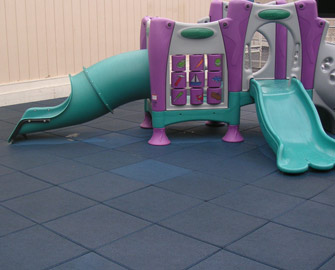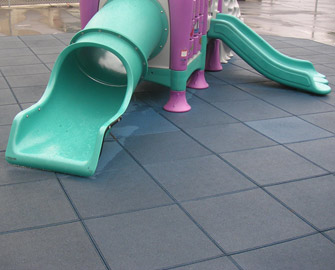 If you’ve been to your share of jungle gyms you have probably seen many different types of playground floor surfaces. At most playgrounds you’ll find sand, gravel, rubber mulch, wood fiber or wood chips covering the floor surfaces. At some of the less equipped jungle gyms, concrete, asphalt, grass or soil may be found. It’s a no-brainer that one should avoid the latter group of floor options at all costs. Yet, among the former group of loose fill flooring surfaces, it is tough to find the best option for a playground; they all offer their own unique benefits. But, what if I told you there’s a solution that trumps all of these flooring options? Let me introduce you to rubber outdoor playground matting.
If you’ve been to your share of jungle gyms you have probably seen many different types of playground floor surfaces. At most playgrounds you’ll find sand, gravel, rubber mulch, wood fiber or wood chips covering the floor surfaces. At some of the less equipped jungle gyms, concrete, asphalt, grass or soil may be found. It’s a no-brainer that one should avoid the latter group of floor options at all costs. Yet, among the former group of loose fill flooring surfaces, it is tough to find the best option for a playground; they all offer their own unique benefits. But, what if I told you there’s a solution that trumps all of these flooring options? Let me introduce you to rubber outdoor playground matting.
Opting to use rubber tiles for a commercial or residential playground surface is becoming quite common today, and for good reason. First of all, it must be mentioned that rubber flooring is an ideal surface for any application, primarily because of its shock-absorbency qualities and grip surfaces. When stacked against other playground surface options rubber tiles outshine the competition and then some.
To understand the versatility of outdoor playground matting, let’s compare rubber tiles to some commonly used playground surfaces:
 Rubber Tiles vs. Sand: Sand feels nice under one’s feet and provides a decent cushion for most falls. It also does not harbor the growth of mold or mildew. Rubber tiles offer such features as well. Yet, unlike sand, rubber mats respond well to humidity and moisture which permeate through the mat—away from kids’ feet—to dry. Sand, unlike tiles, is also a target area for animal waste.
Rubber Tiles vs. Sand: Sand feels nice under one’s feet and provides a decent cushion for most falls. It also does not harbor the growth of mold or mildew. Rubber tiles offer such features as well. Yet, unlike sand, rubber mats respond well to humidity and moisture which permeate through the mat—away from kids’ feet—to dry. Sand, unlike tiles, is also a target area for animal waste.Put rubber outdoor playground matting in the ring with any other playground surface material and the versatile rubber tiles will outperform any of them easily. The tiles are incredibly easy to install and maintain and will last the abuse of scurrying sugar-fueled feet. Rubber matting offers unmatched safety features such as a 6-foot rated fall height and excellent traction. When considering playground surfaces, go with the champ: outdoor rubber flooring tiles!